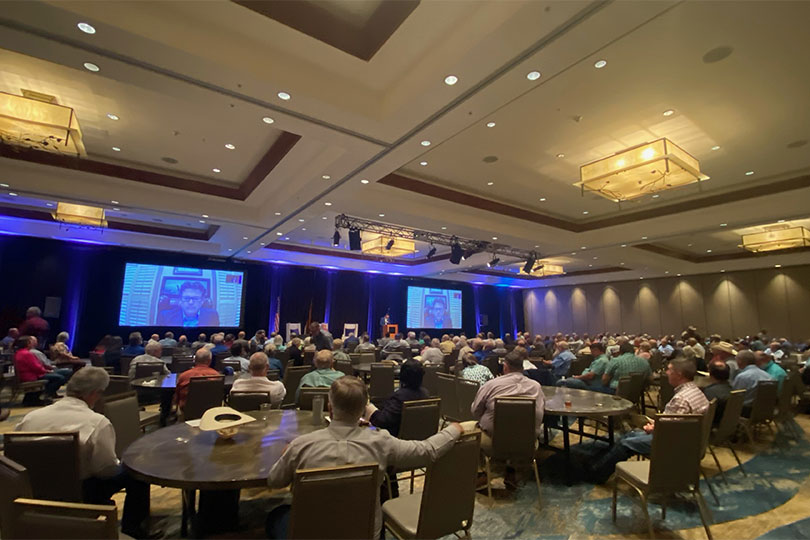By Julie Tomascik
Editor
Rural broadband, feral hogs and farm production costs were among the topics highlighted during the Texas Farm Bureau Summer Conference.
Over 400 farmers and ranchers were in Marble Falls June 20-22 for the meeting that gave an update on agricultural trends, issues and a legislative outlook.
Rural broadband
Texas Comptroller of Public Accounts Glenn Hegar addressed the members, saying agriculture’s impact and what farmers and ranchers do is important to the state.
“Agriculture is the backbone of any society,” he said.
Hegar shared three things that concern him regarding the economy—inflation, supply chain issues and lack of available labor.
“If the last few years have taught us anything, it’s that we don’t know what’s on the horizon,” he said. “But regardless of what’s on the horizon, I have a lot of faith that Texas is going to be okay.”
He provided an update on rural broadband efforts for the state.
“Unfortunately, you have 7 million residents across the state, essentially a quarter of the population, that have no internet service, no connectivity,” Hegar said. “The Legislature last session created what’s called the Texas Broadband Development Office, put it with my office in the Comptroller’s office. So, we went on a 12-city listening tour. We put a plan together on how we’re going to spend federal money. The legislature appropriated, essentially gave to us half a billion dollars, significant amount of money to make sure that we work to build out infrastructure across the state through loans and grant programs with the internet providers and figure out how do we have partnerships, not just within businesses, but also local governmental entities as we try to get that coverage across the state.”
For more information on the broadband plan, visit broadbandfortexas.com.
Feral hogs
A rider included in the state budget during last year’s legislative session allows Texas A&M AgriLife Extension Service and the Texas Department of Agriculture to collaborate on and study an experimental use program evaluating toxicants as a feral hog control method.
Mike Bodenchuk, state director of Texas Wildlife Services, gave an update on the study, noting it has been successful so far.
“The Legislature directed the Wildlife Services Program to do a pilot project with landowners applying Kaput to see if it was efficacious at removing the pigs,” he said. “We’ve been working with landowners in different eco-regions of the state at different seasons of the state. We’ve completed six field trials now that were largely successful.”
The field trials will continue over the next year and a half.
“So far, it looks like it’s very efficacious, and landowners appreciate the opportunity to have a toxicant available,” Bodenchuk said.
Texas has about 3 million hogs statewide that cause over $500 million in damage each year in Texas.
“It’s an ecological and economic train wreck to have pigs in the abundance that we have them,” Bodenchuk said.
DIY farm equipment tools
Repairing farm equipment is especially important as labor shortages are affecting dealerships.
Representatives from John Deere and United Ag & Turf gave an overview of programs and services available to help farmers and ranchers diagnose issues and repair equipment themselves.
“You have the right to repair your equipment but not to make modifications,” Joe Jaska, John Deere territory customer support manager said. “That’s why you don’t have access to the embedded code to revise or control the system. It’s mainly a safety issue.”
But farmers and ranchers do have access to John Deere’s customer service advisor, JD Link, the operations center and the John Deere app center—a single source for all John Deere’s apps.
“This isn’t new stuff, but we want to make sure you know what’s available and how to access this information,” Nick Taylor, United Ag & Turf manager of customer engagement, said. “There are many avenues for do-it-yourself repairs. You can reach out to your local dealership or go to johndeere.com for more information about those resources.”
Commodity prices, input costs
Farm production costs have increased significantly due to inflation and supply chain issues. Through a recent study, the Agricultural and Food Policy Center (AFPC) at Texas A&M University estimated costs of production across all inputs and the bottom-line impact for farmers.
The study found significant increases in input prices will result in a major decline in net cash farm income in 2022 compared to 2021. But despite the significant reduction from 2021, commodity prices will likely still result in increased net cash farm income for most farms.
“But the question is: are the prices going to hold?,” Fischer asked. “The bottom line is this is an historic amount of a capitol is at risk. So where do we go from here?”
Fischer touched on farm bill negotiations that are beginning on Capitol Hill and noted that the current farm safety net doesn’t address the inflated costs of production.
Additional conference sessions
Additional sessions during the conference covered cattle market legislation, the Endangered Species Act, the Texas Right to Farm Act and a recap of the 2022 primary election, along with a general election outlook.
Harley Jarzombek, a young Goliad County Farm Bureau member, also shared about the donation efforts she coordinated to get hay to wildfire victims in Eastland County.
Kornelis ‘Kees’ Huizinga, a Ukrainian farmer, visited with attendees via Zoom about what it’s like farming in a war zone as Russia continues its invasion.
And Dr. Jeffry Savell, vice chancellor and dean of the Agriculture and Life Sciences Department for Texas A&M AgriLife, shared his vision, goals and how AgriLife is setting the stage for the future.


Leave A Comment